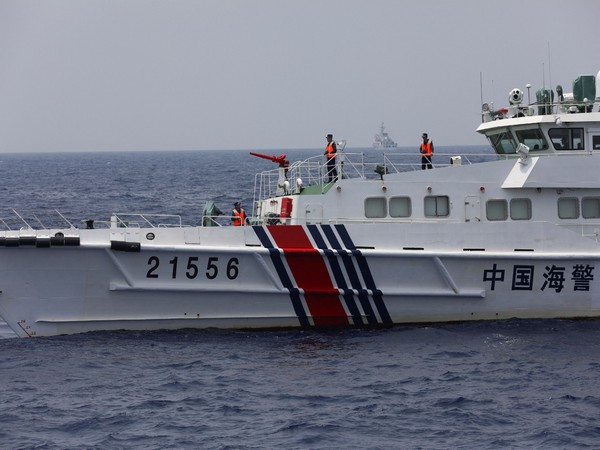Hong Kong, June 11 (ANI): The China Coast Guard (CCG) is far more than a maritime law enforcement agency. Rather, this force directly under the control of China’s all-powerful Central Military Commission is a blunt tool in the hands of the regime. Enforcing China’s will on hapless foreign fishermen, and stealing territory from other nations, is among its bread-and-butter tasks. Worryingly, it is now ready to venture deep into the Pacific Ocean.
As the world’s largest maritime law enforcement agency, the CCG has more than 150 regional and oceangoing vessels displacing at least 1,000 tons. It also has approximately 50 vessels in the 500-1,000-ton class, and around 300 smaller coastal patrol boats.
China intimidated Taiwan yet again with its large-scale Joint Sword-2024A exercise on 23-24 May. This saw People’s Liberation Army (PLA) and CCG assets surround Taiwan and its outlying islands, underscoring the threat of a future Chinese quarantine or blockade of Taiwan.
Earlier, in February, the CCG stepped up patrols around the Kinmen Islands just kilometres from the Chinese coast. In mid-May, Chinese state media said this Kinmen model of law enforcement “can also be applied to Matsu and Penghu Islands, and even the entire Taiwan Strait”.
The CCG has been particularly active enforcing spurious Chinese territorial claims in the South China Sea. Its vessels have repeatedly rammed and fired water cannons at Philippine boats, particularly those resupplying a military garrison on Second Thomas Shoal.
Indeed, a Philippine Coast Guard vessel recently encountered a swarm of 30 plus maritime militia, three CCG vessels, three PLA Navy (PLAN) warships and three research vessels in Escoda Shoal. It is also commonplace for CCG vessels to approach and track Japanese fishing boats near the Senkaku/Diaoyu Islands.
The CCG can use its heavily armed vessels to support the PLAN in both peacetime and war. Indeed, many of its vessels – such as 20 Type 056 corvettes – are hand-me-downs from the PLAN. Complicating the issue, China wields the state-funded People’s Armed Forces Maritime Militia (PAFMM), whose vessels and crews routinely bully Filipino and Vietnamese fishermen in the South China Sea.
Use of the PAFMM’s 235+ large, steel-hulled fishing vessels in a coercive way is designed to frustrate effective responses from offended parties. By using the CCG and PAFMM, China is employing hybrid warfare, also often called “gray-zone tactics”.
Recently retired Admiral John Aquilino, commander of the US Indo-Pacific Command, described it as a “boiling frog” strategy to normalise aggression and to increase their scope and scale over time.
It is imperative that the rest of the world exposes China’s bellicose behaviour, and Manila has been doing that. Commodore Jay Tarriela of the Philippine Coast Guard commented: “What I find truly fascinating about China is their ability to employ deception, denial and false narratives while projecting a facade of concern for regional stability.”
“They excel at crafting statements and narrating events in a way that convinces others of their peaceful intentions and care for the marine environment. However, our commitment to transparency has effectively exposed their true actions and motives. Through compelling images and videos, we have consistently revealed the falsehoods behind their convincing lies,” he added.
Commodore Tarriela continued, “Our primary objective is to expose the truth and unveil their pretense, so that they come to realise that no amount of deceit can conceal their ambitious and greed-driven agenda of controlling the entire South China Sea.”
China’s violent actions caused its popularity to plummet in the Philippines. A March survey conducted by the OCTA Research Group revealed 91 per cent of respondents distrust China. Distrust has risen to its highest-ever level there.
The Asia Maritime Transparency Initiative (AMTI) of the US-based Center for Strategic and International Studies summarised Chinese activity in the South China Sea in 2023: “The China Coast Guard remains the dominant state actor in disputed waters of the South China Sea. Analysis of automatic identification system (AIS) data shows that the CCG continued to maintain daily patrols at key features across
the South China Sea in 2023. Taken together with the CCG’s leadership during confrontations with other claimants like the Philippines, these patrols demonstrate the centrality of the CCG in China’s peacetime operations to assert control over its vast claims in the South China Sea.”
AIS tracking data analysed by AMTI covered Second Thomas Shoal, Luconia Shoals, Scarborough Shoal, Vanguard Bank and Thitu Island. The number of calendar day patrols by the CCG at Second Thomas Shoal increased to 302 last year, from 279 in 2022. Similarly, CCG patrols at Luconia Shoals within Malaysia’s exclusive economic zone (EEZ) rose from 316 days to 338 last year. At the five aforementioned locations, CCG patrols clocked up 1,652 ship days, although the figure is likely to be higher because of China’s propensity to turn off AIS on its ships.
AMTI predicted: “The CCG has already made headlines several times in 2024 for using water cannons against Philippine supply ships at Second Thomas Shoal. But the CCG’s continuous patrols at all corners of the Nine-Dash Line mean that it’s only a matter of time before a close encounter occurs with Vietnam or Malaysia.”
Illustrating China’s modus operandi, the PAFMM has staked out Iroquois Reef 125 nautical miles from the coast of Palawan, well within the Philippine EEZ. A satellite image taken in April showed two groups of rafted vessels at the southern end of the reef. Rafting is a well-attested Chinese practice where Spratly Backbone Fishing Vessels are tied together at anchor to create a semi-permanent presence.
As a gray-zone tactic, China can argue the presence of its vessels is both legal and unremarkable. The CCG also dispatched a vessel to Iroquois Reef to conduct an intrusive patrol, another favoured tactic of China. If it can establish a continual presence, it gradually normalises claims and seizes de facto control, even if the feature legally belongs to another nation. Possession is nine-tenths of the law, and
China is happy to put that to the test. Worryingly, the CCG will soon be venturing deep into the Pacific Ocean as, for the first time ever, it is going to officially operate in the Western and Central Pacific Fisheries Commission Convention Area (WCPFC). This regional fisheries organisation is designed to manage and sustain migratory fish stocks in the western and central Pacific Ocean.
The CCG’s presence will be heavy too, with 26 vessels authorised to carry out fisheries inspections and enforcement. Significantly, the area covered by the WCPFC encompasses the so-called First, Second and Third Island Chains. The zone stretches from the Aleutian Islands in the north to nearly the Antarctic in the south, and from the continental Asian coast to beyond Polynesia in the east. From 30 June, designated CCG vessels are permitted to legally board any foreign fishing vessel on the high seas for the next year.
This Chinese contingent will mean the country has the third-largest maritime security presence in the Pacific, behind the USA and Australia. This development is alarming, given the antics of the CCG in the South China Sea and East China Sea as it recklessly endangers and bullies competitors. Furthermore, China’s fishing fleet is the worst offender in terms of illegal, unreported and unregulated fishing in the Pacific.
With the CCG set to supervise and enforce the “law” in the WCPFC, is this not akin to putting the fox in charge of the chicken coop?
A new Coast Guard Law enacted in January 2021 gave the CCG powers in “sea areas under the jurisdiction of the People’s Republic of China”.
Deliberately left ambiguous, the law does not define this jurisdiction, whether it be internal waters, territorial sea, contiguous zone, EEZ, continental shelf or areas that China illegally claims for itself.
The Coast Guard Law also refers to “national sovereignty,” “national security” and “defence,” meaning the agency can perform military activities. Furthermore, the regulations allow for the “use of weapons,” which is physical force to ensure the effectiveness of law enforcement activities.
On 15 May, China announced it would roll out further regulations authorising the CCG to detain suspects accused of “trespassing” China’s borders for up to 60 days without trial. These rules come into force on 15 June, leaving neighbours anxious that China will arbitrarily arrest any it deems to be in its territorial waters.
Of course, this is the crux of the matter, for China is claiming great swathes of maritime territory to which it has no legal entitlement.
The Philippine Department of Foreign Affairs verbalised the alarm that China’s neighbours feel about such a unilateral law, especially because China does not abide with the 1982 United Nations Convention on the Law of the Sea (UNCLOS), of which it is a signatory.
In its statement published on 26 May 2024, Manila expressed “serious concern” because “a state’s domestic laws may not be applied and enforced in the territory, maritime zones or jurisdiction of other states, nor violate other sovereign states’ rights and entitlements under international law. These same domestic laws cannot be applied nor enforced in the high seas under international law.”
The Philippines also noted these updated regulations are issued on the basis of the 2021 Coast Guard Law, which “illegally expanded the maritime law enforcement powers of China’s Coast Guard. China would be in direct violation of international law should it enforce these new regulations in the waters and maritime features within the illegal, null and void and expansive Ten-Dash Line…”
Chinese Vice-Minister of Foreign Affairs Sun Weidong recently said: “The primary security challenge in the South China Sea originates from outside the region. External forces, spearheaded by the US for geopolitical motives, have manipulated bloc politics and fostered confrontations among camps. They have advanced military deployments and operations in the South China Sea, fueling the escalation of disputes and contradictions concerning the sea. This has undermined the legitimate rights and interests of littoral countries.”
However, Doctor Collin Koh, Senior Fellow at the Institute of Defence and Strategic Studies in Singapore, argued back: “The primary security challenge in the South China Sea originates from Beijing’s insistent defiance of international law, especially UNCLOS, its militarisation of the area and coercive behaviours against its Southeast Asian co-disputants. Stop scapegoating others and covering up for your wrongdoings,” he urged.
China posits that UNCLOS does not govern all matters relating to the international law of the sea. Beijing claims the scope of UNCLOS is limited, and that “historical rights” trump it because they predate it. However, such an approach was soundly rejected by the Permanent Court of Arbitration in July 2016 in a case brought by the Philippines.
The increasing power, reach and robustness of the CCG is deeply unsettling, as Chairman Xi Jinping uses it as a tool to assert new territorial claims and punish those who stand in his way.
AMTI noted problems in how Taiwan, the US and others should respond to these scenarios. “First, there is a misperception that the CCG is similar to the coast guards of most other countries. Internationally, including in East Asia, most coast guards are civilian-led law enforcement organisations, rather than part of a country’s military, particularly during peacetime.”
However, the CCG is a true paramilitary force and can conduct military operations in peacetime, and this needs to be widely publicised.
“Second, the PRC could tailor a CCG-led quarantine of Taiwan to try to minimise international involvement and complicate decision-making. For example, China would not have to close off the Taiwan Strait to encircle Taiwan. It could selectively isolate certain ports or Taiwan-bound shipping without disrupting maritime traffic as a whole. Doing so would complicate the decisions of the United States and other countries on how to respond – and even whether a response is warranted at all.”
Taiwan, the USA and allies thus need to plan beforehand what their threshold is. The third issue is that the CCG is the largest such force in the world, and no single country is equipped to respond to the sheer number of vessels that China can muster. This requires likeminded allies to cooperate and work together to counter China’s blatant gray-zone methods. (ANI)
Disclaimer: This story is auto-generated from a syndicated feed of ANI; only the image & headline may have been reworked by News Services Division of World News Network Inc Ltd and Palghar News and Pune News and World News
HINDI, MARATHI, GUJARATI, TAMIL, TELUGU, BENGALI, KANNADA, ORIYA, PUNJABI, URDU, MALAYALAM
For more details and packages
















